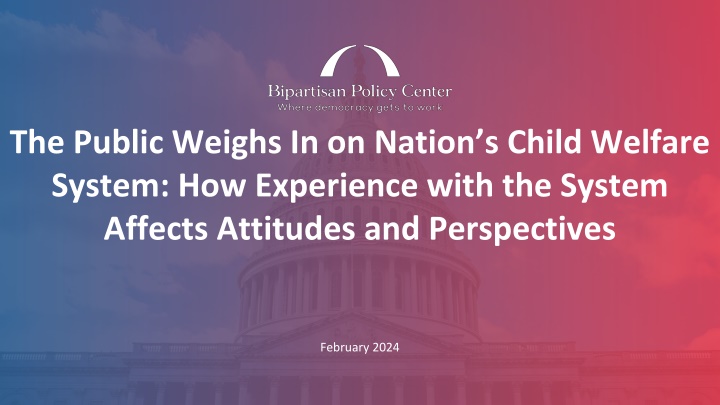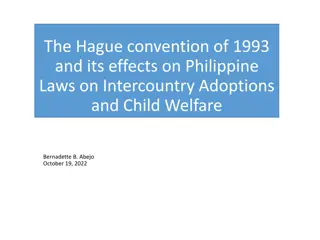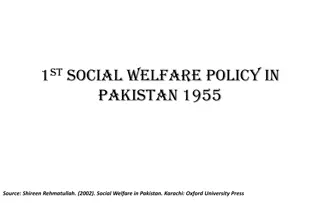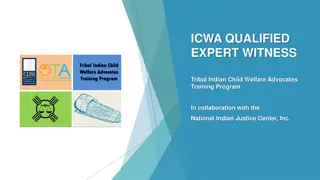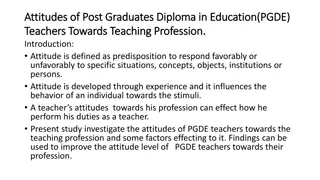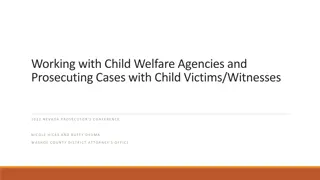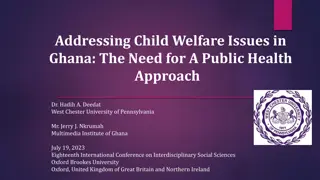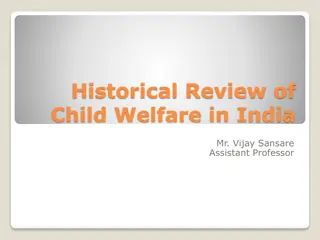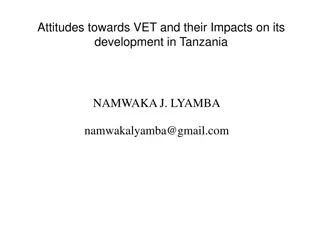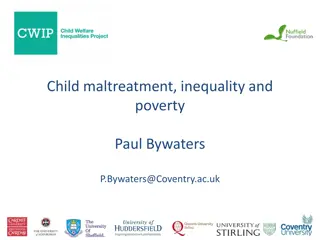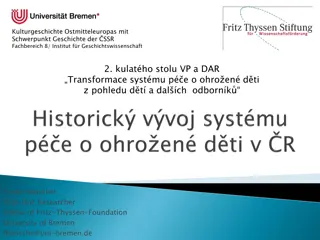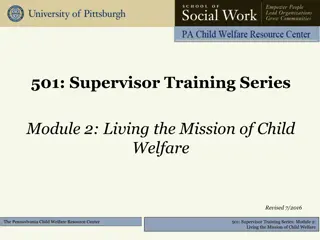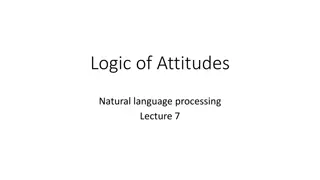Public Attitudes Towards the U.S. Child Welfare System
The Harris Poll and Bipartisan Policy Center conducted a survey to gauge public attitudes towards the U.S. child welfare system. The survey revealed that regardless of experience with the system, Americans generally hold similar views on the causes of child abuse and neglect. However, those with personal or non-personal involvement in the system are more likely to believe that abusive parents can provide safe and nurturing care. The study aims to elevate a vision for protecting children and supporting families through reform efforts and initiatives.
Download Presentation

Please find below an Image/Link to download the presentation.
The content on the website is provided AS IS for your information and personal use only. It may not be sold, licensed, or shared on other websites without obtaining consent from the author.If you encounter any issues during the download, it is possible that the publisher has removed the file from their server.
You are allowed to download the files provided on this website for personal or commercial use, subject to the condition that they are used lawfully. All files are the property of their respective owners.
The content on the website is provided AS IS for your information and personal use only. It may not be sold, licensed, or shared on other websites without obtaining consent from the author.
E N D
Presentation Transcript
The Public Weighs In on Nations Child Welfare System: How Experience with the System Affects Attitudes and Perspectives February 2024
BPCs Child Welfare Initiative In July 2023, Harris Poll and the Bipartisan Policy Center conducted a groundbreaking national survey to gauge public attitudes toward the U.S. child welfare system following the launch of BPC s Child Welfare Initiative. Building on recent state and federal reform efforts, BPC s new Child Welfare Initiative will tackle key issues including preventing and responding to child neglect and abuse, adoption, foster care, and other areas with the goal of elevating a vision for protecting children and supporting families. While experience with the system through personal or nonpersonal involvement certainly alters respondents views on aspects of the child welfare system, there is also a lot of agreement on the causes of abuse and neglect as well how the system should operate. A A a A 2
Methodology Weighting: Data are weighted to ensure results are projectable to the U.S. general population. Survey results are accurate to within 2.9 percentage points using a 95% confidence level. This credible interval will be wider among subsets of the surveyed population of interest. Some responses may not add to 100% due to rounding or due to selection of responses not included in the chart including "unsure." Audience: 2,013 U.S. adults age 18+ Mode: Conducted online in the U.S. by The Harris Poll on behalf of the Bipartisan Policy Center Survey Timing: 15 minutes Fielded from June 29 July 19, 2023 Statistical Significance Responses that were statistically significant are denoted with PI (personal involvement), NPI (non- personal involvement), or NI (no involvement) directly in the chart for the relevant bars. A A a A 3
Breakdown of Respondents by Lived Experience
What personal experience, if any, do you have with the U.S. child welfare system? 24% 18% Responses for total population. Respondents were able to select multiple responses so totals may add to more than 100%. As such, many respondents noted both personal and non-personal experience in the sample. Altogether, 35% of respondents had at least some experience with the system. A A a A 65% 5
Public Perceptions of Child Neglect and Abuse
Key Takeaways on Perceptions of Child Neglect and Abuse Regardless of involvement with the system, Americans generally have similar views on why child abuse and neglect occurs, though: Americans have similar views on parents who have been NEGLECTFUL, however, those with personal or non-personal system involvement are more likely to believe ABUSIVE parents can provide safe and nurturing care. [Slides 12, 13] Those with personal or non-personal system involvement are more likely to believe abuse and neglect are not the parents fault, but the majority of all groups believe maltreatment is intentional. [Slide 12, 15] A A a A 7
Which of the following factors do you think are significant contributors to why CHILD NEGLECT occurs? A Responses reflect top five responses for the total population broken down by party affiliation. Respondents could select all that apply. See Top Line Data for additional response options. A a A 8
Which of the following factors do you think is typically the primary cause of CHILD NEGLECT? A A Responses reflect top five responses for the total population broken down by party affiliation. See Top Line Data for additional response options. a A 9
Which of the following factors do you think are significant contributors to why CHILD ABUSE occurs? A Responses reflect top five responses for the total population broken down by party affiliation. Respondents could select all that apply. See Top Line Data for additional response options. A a A 10
Which of the following factors do you think is typically the primary cause of CHILD ABUSE? A A Responses reflect top five responses for the total population broken down by party affiliation. See Top Line Data for additional response options. a A 11
Public Perceptions of Parental Neglect and Abuse A A Responses reflect those who strongly agree or somewhat agree. a A 12
Parents who have been ABUSIVE can provide safe and nurturing care for their children when they receive needed supports. A A a A 13
I am more understanding of parents involved in cases of child abuse or neglect if I know they are trying to get help or find a way out of their situation. A A a A 14
I think that most acts of child neglect or abuse usually aren't the parent's fault, but rather a product of unfortunate circumstances. A A a A 15
Public Perceptions of the Ideal U.S. Child Welfare System
Key Takeaways on Perceptions of the Ideal Child Welfare System Experience with the system affected respondents' perspectives on the role of government in intervening in families' lives. Those with non-personal system involvement are more likely to favor government s interest in ensuring children s well being over parents authority. [Slide 21] However, those without system involvement are more likely to believe the system should favor protecting children over strengthening families. [Slide 23] A A a A 17
Key Takeaways on Perceptions of the Ideal Child Welfare System Regardless of involvement with the system, Americans have similar views on how reporting and investigation of abuse and neglect should operate. Americans agree they would need evidence of harm (not just risk of harm) to make a report. [Slide 24] Americans agree on specific circumstances that warrant an investigation of abuse and neglect. [Slide 25, 26] Americans believe that agencies should have evidence of harm (not just risk of harm) to investigate. [Slide 27] When in doubt, Americans agree the system should err on the side of investigating reports. [Slide 28] A A a A 18
Key Takeaways on Perceptions of the Ideal Child Welfare System System involvement affects Americans views of how other parts of the child welfare system should operate. Those with personal and non-personal system involvement are more likely to favor keeping children with their family, though all groups lean this way. [Slide 29] Those with non-personal system involvement are less likely to support giving parents time to address challenges and are the only group to support minimizing the time children remain in care when seeking a balance. [Slide 30] A plurality of all groups believe the current policy gives parents enough time to address challenges, though those with system and personal involvement are more likely to believe that the current policy does not give parents enough time AND are also more likely to say it s far too much time. [Slide 31] A A a A 19
Key Takeaways on Perceptions of the Ideal Child Welfare System System involvement affects Americans views of how other parts of the child welfare system should operate. Those with personal or non-personal system involvement are more likely to see community or religious organizations as more effective than government in responding to abuse and neglect. [Slide 22] Americans have similar views on adoption, but those non-personally involved are more likely to believe adopted children should avoid contact with their biological family. [Slide 32] Americans are extremely supportive of involving extended family regardless of system involvement. [Slide 33] A A a A 20
In balancing parents' authority with the government's interest in ensuring the well-being of children, should our country...? Chart shows net (aggregate) of responses on a scale of 1-3 (favor parents' authority) to 4-6 (favor the government's interest in ensuring children's well-being). Net totals reflect that one response was selected on either side of the scale. Respondents could also select not sure, which is not reflected in the chart. A A a A 21
Which best reflects who you think is most effective at responding to concerns of child abuse and neglect? A A a A 22
In an ideal world, which of the following reflects your position on the primary purpose of the child welfare system in this country? Chart shows net (aggregate) of responses on a scale of 1-3 (favor protecting children) to 4-6 (favor strengthening families). Net totals reflect that one response was selected on either side of the scale. Respondents could also select not sure, which is not reflected in the chart. A A a A 23
What is the minimum level of evidence you would need to feel comfortable filing a report where you suspected or knew that a child was being or had been abused or neglected? A A a A 24
Do you believe that any of these scenarios should lead to an investigation by child welfare authorities? A Chart shows responses for child welfare authorities should investigate. Respondents were also given the option of another government of community agency should offer support or not sure. A a A 25
Do you believe that any of these scenarios should lead to an investigation by child welfare authorities? (continued) A Chart shows responses for child welfare authorities should investigate. Respondents were also given the option of another government of community agency should offer support or not sure. A a A 26
In your opinion, which of the following is the minimum amount of evidence that child welfare authorities should need to investigate? A A a A 27
Which most closely reflects your position on how the U.S. child welfare system should decide whether to investigate reports of abuse or neglect? Chart shows net (aggregate) of responses on a scale of 1 (investigate every report) to 6 (only investigate when there is compelling evidence). Net totals reflect that one response was selected on either side of the scale. Respondents could also select not sure, which is not reflected in the chart. A A a A 28
Which most closely reflects your position on how the U.S. foster care system should work when it comes to considering removal of a child? Chart shows net (aggregate) of responses on a scale of 1-3 (with 1 being heavily favor removing child) to 4-6 (with 6 being heavily favor keeping child with family). Net totals reflect that one response was selected on either side of the scale. Respondents could also select not sure, which is not reflected in the chart. A A a A 29
Which most closely reflects your position on how the U.S. foster care system should decide how long parents should be given to address challenges? Chart shows net (aggregate) of responses on a scale of 1-3 (with 1 being heavily favor giving parents more time) to 4-6 (with 6 being heavily favor minimizing time in foster care). Net totals reflect that one response was selected on either side of the scale. Respondents could also select not sure, which is not reflected in the chart. A A a A 30
In your opinion, do you feel that approximately 15 months is the appropriate length of time for parents to show they are addressing issues that interfere with their ability to parent? A A a A 31
Public Perceptions of the U.S. Adoption System A A Responses reflect those who strongly agree or somewhat agree. a A 32
Public Perceptions on the Role of Extended Family A A a A Responses reflect those who strongly agree or somewhat agree. 33
Public Perceptions of How the System Currently Functions
Key Takeaways on Perceptions of How the System Currently Functions System involvement affects Americans perception of how the system is operating. Those with personal and non-personal system involvement are much more familiar with system, but many of those without involvement have some familiarity as well. [Slide 37] Those with personal and non-personal system involvement rely most on personal experience for their knowledge of the system, while those without system involvement rely most on news or media outlets. [Slide 38] A majority of all groups believe that the system does more good than harm. [Slide 43] A A a A 35
Key Takeaways on Perceptions of How the System Currently Functions System involvement affects Americans perception of how the system is operating. Those with personal and non-personal system involvement are more likely to see the child welfare system as government overreach. [Slide 44, 46] Those with personal system involvement are more likely to believe that child welfare system perpetuates oppression. [Slide 44, 45] Those with personal system involvement are more likely than all others to see both socioeconomic and racial bias in decisions made by the child welfare system. [Slide 47] Those with personal system involvement are more likely to believe that decisions to intervene made by the child welfare system are influenced by racial biases. [Slide 47, 49] A A a A 36
How familiar would you say you are with the child welfare system as a whole? A A a A 37
Which source have you relied on most to inform what you know about the current U.S. child welfare system? A A Responses reflect top five responses for the total population broken down by party affiliation. See Top Line Data for additional response options. a A 38
Overall, how positive or negative is your perception of the current U.S. child welfare system? Chart shows net (aggregate) of responses on a scale of 1-3 (with 1 being very negative) to 4-6 (with 6 being very positive). Net totals reflect that one response was selected on either side of the scale. Respondents could also select not sure, which is not reflected in the chart. A A a A 39
Overall, how would you rate how the current U.S. child welfare system functions? Chart shows net of responses on a scale of 1-3 (with 1 being The U.S. child welfare system is an inherently broken system that can't be fixed ), 4 ( The U.S. child welfare system functions the way it was designed to operate ), and 5-7 (with 7 being The U.S. child welfare system is high-functioning ). Net totals reflect that one response was selected on either side of the scale. Respondents could also select not sure, which is not reflected in the chart. A A a A 40
How much of a challenge do you see the following when it comes to the obstacles that the current U.S. child welfare system faces? A Responses for somewhat of a challenge and a significant challenge. Respondents could also answer with not at all a challenge. A a A 41
How much of a challenge do you see the following when it comes to the obstacles that the current U.S. child welfare system faces? (continued) A Responses for somewhat of a challenge and a significant challenge. Respondents could also answer with not a challenge at all. A a A 42
Public Perceptions of How the U.S. Child Welfare System Works A A Responses for those who strongly agree and somewhat agree. a A 43
Public Perceptions of How the U.S. Child Welfare System Works (continued) A A Responses for those who strongly agree and somewhat agree. a A 44
The child welfare system perpetuates the oppression of marginalized populations. A A a A 45
The child welfare system is an example of government overreach. A A a A 46
Public Perceptions of Bias in U.S. Child Welfare System A A Responses for those who strongly agree and somewhat agree. a A 47
Too often, decisions on whether the child welfare system should intervene in families are influenced by socioeconomic/poverty biases. A A a A 48
Too often, decisions on whether the child welfare system should intervene in families are influenced by racial biases. A A a A 49
Appendix: About the Child Welfare System Respondents were given the following definition at the start of the survey: The child welfare system is governed by a set of federal and state policies. The overall mission of federal, state, and local child welfare agencies is to provide for the safety, stability, and well-being of children who ve been abused or neglected, or are at risk of abuse and neglect. Child welfare services vary from state to state but in general the main responsibilities include: Receiving and investigating reports of possible child abuse and neglect. Providing supportive services to families to prevent child abuse or neglect. These include mental health services, substance abuse treatment programs, and in-home parenting support, among others. Providing an alternative home for children via foster or kinship care or a group home when it's determined (by courts) that they cannot remain safely at home. Helping children leave foster care to be safely cared for by a permanent family, by reuniting them with their birth parents, or connecting them with relatives who serve as guardians or with adoptive families. This includes providing services to these families to promote safety and stability, so the child does not need to return to foster care. A A a A 50
